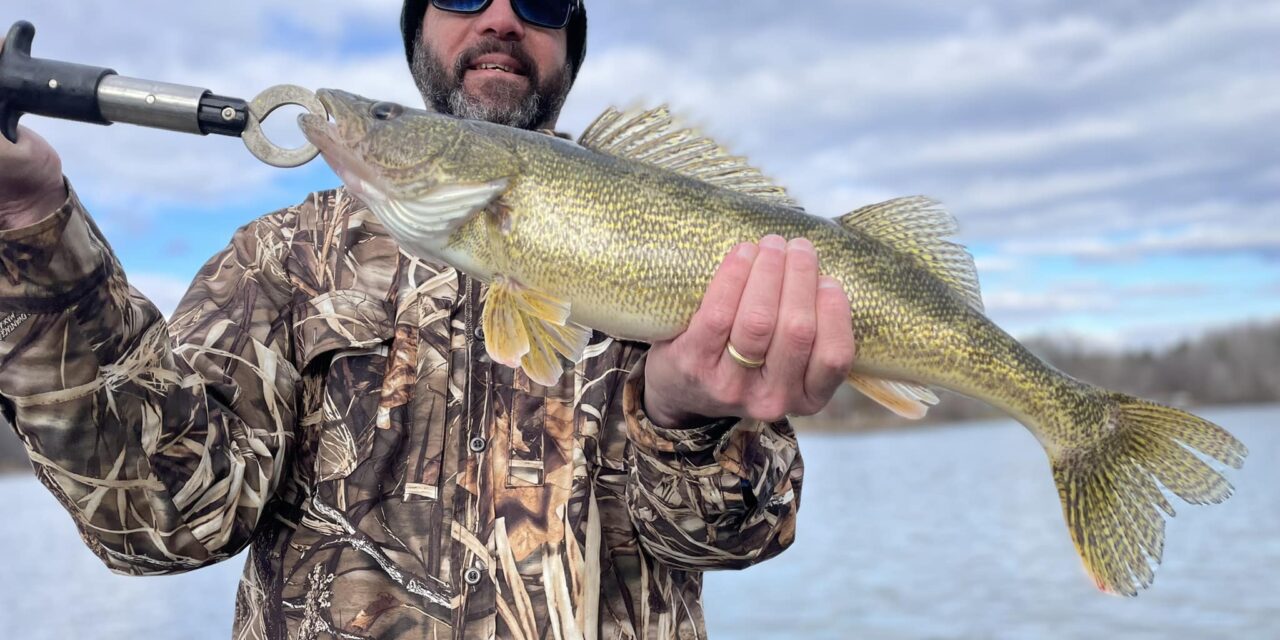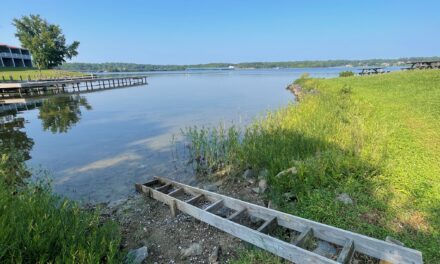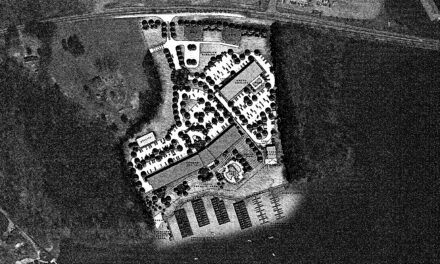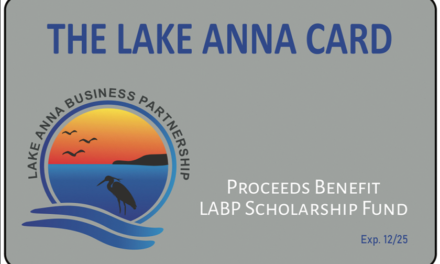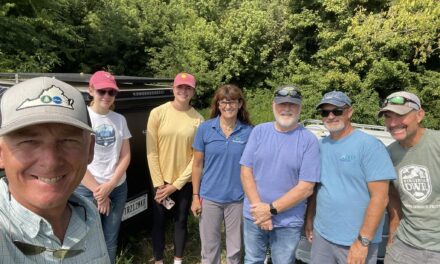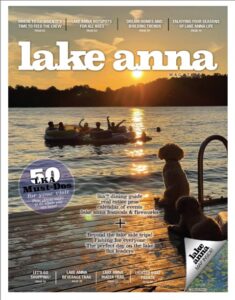For most Lake Anna anglers, a saugeye is an unfamiliar name or a strange fish caught in Minnesota. For a select few, nothing could be farther from the truth.
Lake Anna is part of a Department of Wildlife Resouces program to stock this hybrid. In fact, saugeye have been added to DWR stockings since 2014. This fish is a cross between a female walleye and a male sauger that proves hardier in warmer fisheries – a good fit for Lake Anna’s often 90+ degree water.
Long time Lake Anna guide C.C. McCotter has been following the walleye and now saugeye stockings for the past 36 years. Recently, he’s been enjoying a winter run of saugeye on the lake including one hefty specimen nearly five pounds and measuring 24” – the state’s trophy fish mark. He and clients have caught numerous saugeyes this winter from 19-22” and he’s thrilled to have another new resident in the lake.
“When I caught my first little one a few years back I was surprised and intrigued. When I caught my first big one this winter, I was pumped! Saugeyes are so much better than the walleyes stocked 20 years ago. These new fish actually bite reliably, fight hard and are distributed throughout the lake,” he told W2 recently, “In eight trips in a row this winter we’ve caught them and released all but one.”
DWR Biologist John Odenkirk has been managing Lake Anna as long as McCotter has been guiding. The career scientist notes he, too, is happy with the results of the experimental stocking of saugeyes into Lake Anna.
“From all accounts, the stocking of saugeye into Lake Anna has been a huge positive. Scientifically, we are seeing some good trends,” Odenkirk told W2.
He cited a gill net survey catch rate of saugeye that established a second consecutive record at 9.9/net night (more than double 4.6/net night in 2022).
“An astonishing 357 saugeyes were caught during the survey, with 73% young of year (mean TL=296 mm TL or around 12 inches). Fingerling stockings contributing to this catch included 5/ac (2021), 1/ac (2022), and 12/ac (2023).” Odenkirk noted that fry stockings of saugeye AND walleye occurred in 2021 and 2023 respectively. So, yes, the anglers that said they caught a walleye recently, could possibly have caught one.
Walleyes are native to central North American and Canada including the Ohio River and Great Lakes watersheds. The sauger is closely related to the walleye and very similar in appearance. Saugers are native to much of central North America, including the Mississippi and Missouri River watershed and the the Great Lakes and Hudson Bay watersheds.
To determine if you’ve caught a saugeye or walleye, first look at the spiny dorsal fin. The walleye will have no spots on this fin and the hybrid saugeye will have spots and bars in the webbing of its spiny dorsal fin. The color of the fish and the presence or absence of the cheek scales may also help identify the difference. The eyes of this species give off an eerie glow due to the tapetum lucidum, a reflective layer on the retina, This adaptation is for feeding at night in low light levels.
As a hybrid, the saugeye has the advantage of “hybrid vigor”, growing larger than the sauger parent.
According to Odenkirk, saugeye at age two averaged 534 mm TL (21 inches), exceeding the minimum length limit after less than three growing seasons!
McCotter notes he’s catching the saugeyes this winter on Anna using mostly crankbaits and swimbaits around rock in 6-15’ with current, though many have also been caught in much deeper water by anglers using blade baits, spoons and live minnows.
“They hit like a striper or wiper and fight hard right to the net. They often surge at the last second to avoid it,” he warns.
According to studies, saugeye spawn at night when water reaches 45-50 degrees. Eggs are scattered randomly in rocky or gravelly shoals, often where current is present. The eggs fall into protected spaces in rocks and gravel, hatching about 12-18 days later depending on water temperature. Each fish can produce up to 25,000 eggs per pound of body weight! Adult fish return to deep water after spawning.
This means that early March should be a good time to catch your first saugeye at Lake Anna and if you want to get serious about pursing them deep, you may be able to continue catching them into early summer.
The limit on Lake Anna for saugeye is five per angler per day over 18 inches.
Sidebar
As far as the best fisheries and where to find walleye/saugeye in them, Palmer told W2 walleye in the Staunton and New River make huge spawning runs in the March and April. According to the 2021 DWR Walleye Fishing Forecast, walleye and saugeye fishing has really taken off in the Staunton, especially from Leesville dam to Altavista. Quality walleye are now consistently being caught and sampled all the way to Brookneal.
Another benefit of the stockings into Leesville and the Staunton River is a boost in the walleye fishery at Kerr Reservoir. While they’re still hard to target in this 50,000 acre reservoir, the opportunity to catch a walleye is improving each year.
Anglers catch most walleye in the upper New River around Ivanhoe, Foster Falls, and Allisonia using crankbaits, jigs and live minnows in February, March and early April.
Walleye also run up the South Fork of the Holston. Anglers congregate near the community of Alvarado from February through April to catch walleyes on the spring spawning run here.
Currently walleye can be found in the Shenandoah River from Warren Dam in Front Royal downstream beyond the Virginia/West Virginia state line. Although they are not as numerous in the Shenandoah as they are in other rivers they are increasing in number and can reach lengths exceeding 25 inches.
Anglers fishing for walleye on the Shenandoah River should focus their efforts in the deeper pools during the daylight hours. Walleye will move out of the deeper pools into shallow bedrock ledge areas to feed during night hours. There are typically high numbers present between Warren Dam and Morgan’s Ford Access from January through March.
During other times of the year the reservoirs and lakes offer good walleye/saugeye fishing. For big fish, South Holston Reservoir is best with a very fast growth rate from fingerling to 18” in about a year-and-a-half to two years. Burke, Brittle, Orange, Chesdin, Philpott and Hungry Mother are decent, but anglers have to put in the time to find the fish in them.
Northern and central Virginia anglers hoping to catch decent walleye should look no further than Lake Orange. This 124-acre DRW managed lake occasionally produces walleye over five pounds. Electrofishing catch rates were 17 fish/hour in 2020, which increased from the 9 fish/hour in 2019. Spring 2020 surveys resulted in 29% of walleye being harvestable with a 14.6” average.
As noted here, Lake Anna has developed a nice saugeye fishery in the past two years and should continue to offer good opportunities this season and next.
Tidewater anglers should target walleye and saugeye in Little Creek Reservoir. One of the keys to fishing on Little Creek Reservoir is to concentrate on the deeper edges in and around the numerous points that line the shoreline. Some of the best action has come from anglers that slow-troll their baits in the 17 to 20 foot depth range within the western half of the reservoir. Trolled nightcrawlers can be a very productive pattern for anglers to try during the warmer weather months. Dedicated anglers will catch their fair share of Little Creek ‘eyes surprisingly during the summer months if they are able to keep their baits in the deep strike zone. Anglers jigging blade baits along with Rapala Jigging Raps can catch some quality fish from deep water during the cold-water months as well as during the summer.
That’s the history of walleye and saugeye in Virginia. The state record walleye is 15-15 caught from the New River. The state record saugeye is open with a minimum weight of six pounds. Pick a fishery and get out there this month and see if you can catch a state record saugeye. We’ll be happy to cover your story!

